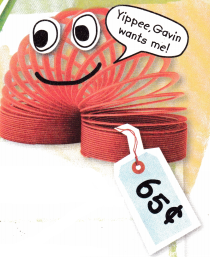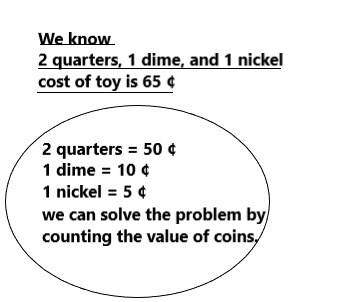All the solutions provided in McGraw Hill My Math Grade 2 Answer Key PDF Chapter 8 Lesson 4 Problem-Solving Strategy: Act it Out will give you a clear idea of the concepts.
McGraw-Hill My Math Grade 2 Answer Key Chapter 8 Lesson 4 Problem-Solving Strategy: Act it Out
Gavin has 2 quarters, 1 dime, and 1 nickel. Does he have enough money to buy this toy?

1. Understand
Underline what you know.
Circle what you need to find.
Answer:

2. Plan
How will I solve the problem?
Answer:
Given,
2 quarters, 1 dime, and 1 nickel
1 quarter = 25¢, 1 dime = 10¢, 1 nickel = 5¢
2 quarters = 50¢.
We can find the given probelm by adding the coins.
Total value of coins = 50 + 10 + 5 = 65¢.
3. Solve
Act it out.

Does Gavin have enough money to buy the toy?
![]()
4. Check
Is my answer reasonable? Explain.
Answer:
Yes my answer is reasonable. Because by counting all the coins we got the answer has 65¢.
Practice the Strategy
Robin wants to buy 3 rings. Each ring costs 20¢. She has 1 quarter, 2 dimes, and 5 nickels. Does she have enough money?

1. Understand
Underline what you know.
Circle what you need to find.
Answer:

2. Plan
How will I solve the problem?
Answer:
Given,
1 quarter, 2 dimes, and 5 nickels
By converting the coins into cents and next add all the coins to get the desired answer.
We can find the given probelm by adding the given number of coins.
3. Solve
I win…
Answer:
70¢.
Explanation:
Given,
cost of each ring = 20¢
He wants to buy three rings = 3 × 20 = 60 ¢
he has 1 quarter, 2 dimes, and 5 nickels to buy
1 quarter = 25¢, 1 dime = 10¢, 1 nickle = 5¢
2 dimes = 20¢, 5 nickles = 25¢
25 + 20 + 25 = 70¢.
He has enough money to buy three rings.
4. Check
Is my answer reasonable? Explain.
Answer:
yes the answer is reasonable.
As we added all the number of coins we found she had enough money to buy her rings.
Apply the Strategy
Question 1.
Maria has 1 quarter in her piggy bank. Her mom gives her a nickel. Her dad gives her a dime. How much money does Maria have in all?

Answer:
Maria has 45 cents in all.
Explanation:
Given,
1 quarter = 25 cents.
1 nickel = 5 cents.
1 dime = 10 cents.
By adding the given money we get 25 + 5 + 10 = 45 cents.
Therefore maria has 45 cents in all.
Question 2.
Mark has 2 quarters, I dime, and I penny. He wants to buy a toy truck for 55¢. Does he have enough money to buy the toy truck?
Answer:
Mark needed 19¢ more to buy the toy truck. Hence he doesn’t have enough money to buy the toy truck.
Explanation:
Given,
Mark has 2 quarters, I dime, and I penny
1 quarter = 25 cents, 1 dime = 10 cents, 1 penny = 1 cent
Total value of coins = 25 + 10 + 1 = 36 ¢.
Mark wants to buy a toy truck for 55¢.
55¢ – 36¢ = 19¢.
Mark needed 19¢ to buy the toy truck.
Question 3.
Wesley has 2 quarters, 3 dimes, and 2 nickels. He has enough money to buy a race car. What is the greatest amount of money that the race car could cost?
Answer:
90¢.
Explanation:
Given,
Wesley has 2 quarters, 3 dimes, and 2 nickels.
1 quarter = 25 ¢. 1 dime = 10 ¢ and 1 nickel = 5 ¢
2 quarters = 50¢, 3 dimes = 30¢, 2 nickels = 10¢
The total value of coins = 50¢ + 30¢ + 10¢ = 90¢
The amount of money he has to buy the race car is 90¢.
Review the Strategies
Choose a strategy
- Act it out.
- Draw a picture.
- Use logical reasoning.
Question 4.
Riley has 1 dime, 3 nickels, and 4 pennies. Does she have enough to buy a cookie that costs 30¢? How much more does she need?
Answer:
She has enough money to buy a cookie that costs 30¢.
Explanation:
Given,
Riley has 1 dime, 3 nickels, and 4 pennies.
1 dime = 10 ¢, 1 nickel = 5 ¢, 1 penny = 1 ¢
3 nickels = 30 ¢, 4 pennies = 4 ¢
Total value = 1 dime + 3 nickels + 4 pennies
= 10 ¢ + 30 ¢ + 4 ¢
= 44 ¢.
Question 5.
Annie has coins to buy a gel pen at the store. It costs 85¢. She has 2 quarters and 1 nickel. What two coins does she still need?

Answer:
The two coins she needed are 3 dimes and 1 Nickel.
Explanation:
Given,
She has 2 quarters and 1 nickel.
Cost of gel pen = 85¢
1 quarter = 25¢, 1 nickel = 5¢
2 quarters = 50 ¢
Total value = 50 + 5 = 55 ¢.
But she needs another 85 – 55 = 30 ¢ more cents.
Therefore she needs 3 dimes and 1 Nickel to make 85 ¢.
Question 6.
A notebook costs 40¢. What three coins could you use to pay for the toy?
Answer:
The three coins he used to pay for the toy are 1 dime, 1 quarter, and 1 nickel.
Explanation:
The cost of a notebook is 40¢.
The three coins he used to pay for the toy are 1 dime, 1 quarter, and 1 nickel.
10 + 25 + 5 = 40¢.
McGraw Hill My Math Grade 2 Chapter 8 Lesson 4 My Homework Answer Key
Problem Solving
Underline what you know. Circle what you need to find. Act it out to solve.
Question 1.
Jose has 1 quarter, 3 dimes, and 1 nickel How much more does he need to buy an airplane that costs 75¢?

____________ ¢
Answer:
He needs 10 ¢ to buy an airplane that costs 75¢.
Explanation:
Given,
Jose has 1 quarter, 3 dimes, and 1 nickel
1 quarter = 25 ¢, 1 dime = 10 ¢, 1 nickel = 5 ¢
3 dimes = 3 × 10 = 30 ¢
total value of coins = 25 + 30 + 5 = 60 ¢
Cost of aeroplane = 75 ¢
75 ¢ – 60 ¢ = 10 ¢.
He needs 10 ¢ to buy an airplane that costs 75¢.
Question 2.
Leah has 1 quarter, 2 dimes, and a nickel. Her sister has 3 nickels. How many more cents do they need to have 90¢?
____________ ¢
Answer:
Therefore he needs 25 ¢ more cents do they need to have 90¢.
Explanation:
Given,
Leah has 1 quarter, 2 dimes, and a nickel
Her sister has 3 nickels
1 quarter = 25 ¢, 1 dime = 10 ¢, 1 nickel = 5 ¢
2 dimes = 20 ¢, 3 nickels = 15 ¢
Total value of coins = 25 ¢ + 20 ¢ + 15 + 5 = 65 ¢
we need to find How many more cents do they need to have 90¢.
90 – 65 = 25 ¢.
Therefore he needs 25 ¢ more cents do they need to have 90¢.
Question 3.
Cole has 75 cents. He has 2 quarters and 1 dime. If the rest of his coins are nickels, how many nickels does he have?
_____________ nickels
Answer:
He have 40 ¢ nickles.
Explanation:
Given,
Cole has 75 cents.
He has 2 quarters and 1 dime.
1 quarter = 25 ¢ 1 dime = 10 ¢
The rest of his coins are nickels. We need to find how many nickels does he have.
25 + 10 = 35 ¢.
75 – 35 = 40 ¢.
The rest 40 ¢ are nickels
1 nickle = 5 ¢, 8 nickels = 40 ¢.
He have 40 ¢ nickles
Question 4.
Sarah has 1 quarter, 1 dime, 3 nickels and 3 pennies. How much money does she have?
_____________ ¢
Answer:
Sarah has 53 cents.
Explanation:
Given,
Sarah has 1 quarter, 1 dime, 3 nickels and 3 pennies.
1 quarter = 25 ¢, 1 dime = 10 ¢, 1 nickle = 5 ¢, 1 penny = 1 ¢
3 nickels =15 ¢, 3 pennies = 3 ¢
Total value of money = 25 + 10 + 15 + 3 = 53 ¢.
Math at Home Have your child show you the coins needed to buy a toy that costs 64¢.
Answer:
Cost of toy = 64¢.
The coins needed to buy a toy are 1 quarter, 2 dimes, 3 nickels, 4 pennies.
1 quarter = 25 ¢, 1 dime = 10 ¢, 1 nickel = 5 ¢, 1 penny = 1 ¢.
1 quarter + 2 dimes + 3 nickels + 4 pennies.
25 + 10 + 15 + 4 = 64 ¢.